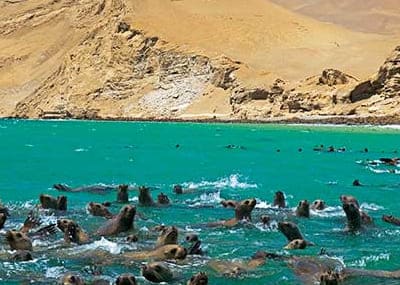Paracas National Reserve: Complete Guide for Your Visit
The Paracas National Reserve is much more than just a natural park. It’s Peru’s only protected marine ecosystem, where the driest desert on the planet meets the cold Pacific Ocean. Its reddish beaches, wind-carved rock formations, unique biodiversity, and rich historical significance make it a must-see destination for any traveler exploring Peru’s southern coast.
Why Visit Paracas National Reserve?
Paracas offers one of the most stunning coastal landscapes in South America. Here you can:
- Walk along one-of-a-kind red sand beaches.
- Watch thousands of migratory and resident birds along cliffs and bays.
- Explore geological formations telling millions of years of natural history.
- Connect with archaeological remains of pre-Inca cultures such as the Paracas civilization.
It’s also an ideal destination for travelers seeking sustainable tourism, respecting both natural and cultural heritage.
History of Paracas National Reserve
Officially created in 1975, the Paracas National Reserve spans over 335,000 hectares (65% marine, 35% desert). However, its history goes back thousands of years, when the Paracas culture inhabited the area (800 BC - 100 AD), leaving behind stunning burial textiles, advanced skull surgery techniques, and the iconic Candelabra geoglyph.
Thanks to the convergence of the cold Humboldt Current and the warmer tropical current, its waters are among the most biologically productive on the planet, sustaining incredible biodiversity.
Main Attractions Within the Reserve
1️⃣ Red Beach: A Natural Spectacle
This beach owes its color to erosion of pink granite rocks breaking into fine red sand. The contrast between intense red and the blue sea creates one of Paracas’ most iconic postcards.
2️⃣ Cathedral Viewpoint
Before the 2007 earthquake, the Cathedral was a large natural rock arch sculpted by centuries of marine erosion. Although part of its structure collapsed, the viewpoint still offers breathtaking ocean and cliff views where seabirds nest.
3️⃣ Lagunillas
A small harbor inside the reserve, perfect for a lunch stop. Here you’ll find restaurants specializing in fresh seafood and local fish. It’s also a great place to observe seagulls, pelicans, and sometimes flamingos.
4️⃣ Paracas Interpretation Center
This modern museum interactively explains the geological formation, biodiversity, pre-Hispanic cultures, and ecological importance of the reserve. It’s highly recommended to start your visit here.
The Unique Biodiversity of Paracas
Although a desert, the cold and nutrient-rich waters generate an extremely rich ecosystem:
- Over 215 bird species (pelicans, cormorants, terns, flamingos, boobies, etc.).
- 20 marine mammal species like sea lions, dolphins, and occasionally humpback whales.
- 180 fish species and numerous invertebrates (shellfish, mollusks, crustaceans).
It’s also a key conservation site for migratory species resting here during their long journeys.
How to Visit the Reserve?
You can explore the reserve:
- On a guided tour: The most comfortable option with transport, organized stops, and full explanations.
- By bicycle: For the more adventurous, bikes are available to rent so you can explore at your own pace.
- Self-driving: Easy to drive with paved, well-signposted roads inside the reserve.
Practical Tips for Your Visit
- Bring a hat, sunscreen, and sunglasses (the desert glare is intense).
- Always carry enough water (there are few stores inside the reserve).
- Wear light clothing but bring a windbreaker, as the coastal breeze is constant.
- Do not feed animals or collect shells or stones—it’s a protected area.
Hours and Entrance Fees
- Open daily, from 8:00 am to 4:00 pm.
- Entry: Around S/ 11 soles (~$3 USD).
- The ticket often includes access to the Ballestas Islands pier as well.
The Cultural Impact of the Paracas Civilization
The name "Paracas" comes from Quechua, meaning “rain of sand” due to the area’s strong winds. The Paracas culture is famous for its intricately embroidered textiles, advanced burial rituals, and of course, the Candelabra geoglyph visible from the boats heading toward the Ballestas Islands.
You can learn more about this culture at the Julio C. Tello Site Museum, located inside the reserve.
Is It Family-Friendly?
Absolutely! The Paracas National Reserve is an excellent educational and visual experience for both adults and children. Kids are often fascinated by the birds, landscapes, and the opportunity to freely explore empty beaches.
Compared to Other Nature Destinations in Peru
- Amazon: tropical rainforest, humidity, lush biodiversity.
- Paracas: marine-desert ecosystem, dry climate, and unique coastal scenery.
- Andes: high altitude, mountains, Andean lakes, and Inca ruins.
Paracas is ideal for those seeking a coastal experience completely different from the typical Cusco-Machu Picchu route.
Frequently Asked Questions (FAQ)
Can it be visited year-round? Yes, it has dry weather year-round, with very little rain.
How much time should I plan for it? At least half a day (4-5 hours) is recommended to fully enjoy the main attractions.
Is camping allowed? No, overnight stays inside the reserve are not permitted.
Is a guide required? Not mandatory, but having a guide greatly enhances the experience.
Final Conclusion
The Paracas National Reserve is a stunning blend of nature, history, and dramatic landscapes. From its red beaches and marine wildlife to its cultural heritage, it offers an experience that combines adventure, learning, and pure contemplation. An absolute must-see on Peru’s coastal route.
